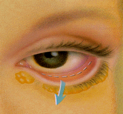

Overview
Eyelid Surgery, otherwise known as Blepharoplasty is a surgical procedure designed to remove fat and excess skin and muscle from the upper and lower eyelids. This can effectively produce a more youthful appearance in the face and is often combined with other cosmetic procedures such as Facelift and Browlift, although it can also be performed alone.
Did you know that it is also not just a cosmetic procedure? It is often used to treat conditions such as dermatochalasis & eyelid ptosis which are medical conditions recognised by Medical Insurance Carriers.
Eyelid Surgery can correct droopy upper eyelids and puffy bags underneath your eyes. It can help reduce the sad or tired look that your face often takes on with age. The results are long-lasting and the eyelid surgery is performed with a minimum of intervention.
Best Candidates
Physically healthy, emotionally stable and who are realistic in their expectations
Suffer from droopy upper eyelids affecting vision
Desire to alter local anatomy, as with an “Asian Blepharoplasty”
Good elasticity in your skin
What to Expect
The aim of this section is to provide you with information on how the surgery is performed and what you can expect from eyelid surgery. Please ask your Surgeon any questions you may have that are not answered adequately here as each person’s individual needs may not be addressed in this information sheet.
As with many cosmetic procedures, Blepharoplasty can enhance your appearance and improve your self-esteem and self-confidence. You must bear in mind, however, it won’t necessarily change your looks to match your ideal or cause other people to treat you differently. Before you decide whether to have eyelid surgery, think this over carefully and discuss any questions or feelings with your Surgeon or our qualified staff. Your eyelids have both a protective and an aesthetic function. They protect the eyes by providing lubrication and act as a shield to foreign objects or light. The eyelids also frame the eyes, giving a pleasing aesthetic appearance, the eyes often being the first thing that people notice when they meet you.
For surgical blepharoplasty, excisions are made that follow the natural creases in the eyelids. The excess tissue, fat and muscle are removed to create the desired effect and the incisions are sutured with microscopic sutures leaving a fine line that will fade very quickly.
This surgery takes between one and three hours, depending on whether only the upper or lower lids are corrected or whether it is both upper and lower lids.
The incisions may be external, just along the lash-line, or internal on the conjunction this so-called “trans-conjunctual blepharoplasty” enable fat but not excess skin removal and is, therefore, most suitable for people without a lot of redundant skint a lot of redundant skin.
Sometimes the lower lid needs to be tightened and this is called Canthoplasty. The eyelid insertion is tightened on the bone. Blepharoplasty or eyelid surgery is required for very lax or droopy eyelids, especially when there are large bags underneath the eyes.

Upper Eyelid Incision Line

Transconjunctival Incision for Lower Eyelid
After Surgery / Recovery
After your surgery, you will be given a list of instructions for eye care in the first few weeks. These instructions will be explained to you in detail and you will be asked to attend the Rooms on a regular basis for monitoring. The eyes will require regular washing and lubrication with antibiotic cream.
You will need to keep your head elevated for several days in order to help reduce swelling. For the first 48-72 hours cold compresses are useful in further reducing this swelling and to help reduce bruising, which can vary from very light, to very heavy in the eye and upper face area. This bruising usually takes two weeks to disperse; however, it may persist for six to eight weeks. Our staff can offer camouflage make-up to conceal this bruising and swelling so that you may resume your normal routines as early as possible. Arnica tablets & Hirudoid cream are helpful in hastening the resolution of bruises.
You may find it difficult to close your eyes to sleep for the first few days or even weeks, however, this should settle with time. Your vision may be slightly blurred as a result of the antibiotic cream, or because of the effects of swelling and bruising from the surgery. This should subside in the first few days.
After two to three days you should be able to resume watching television. You may resume driving after four to five days, however, you should obtain advice on this from our staff or your Surgeon as each individual case varies in this factor. Most people are ready to return to work in seven to ten days, depending on how much swelling is evident. You may be sensitive to sunlight and other irritants for several weeks. You may resume gentle exercise after three to four days, however, you should avoid strenuous exercise or activities that raise your blood pressure (such as bending, lifting and straining) for approximately three to four weeks. Contact lenses should not be used for two weeks. Eye makeup can be worn after seven to ten days.
Healing is a gradual process and your scars may remain slightly pink for six months or more before they fade to a thin, barely visible line.


